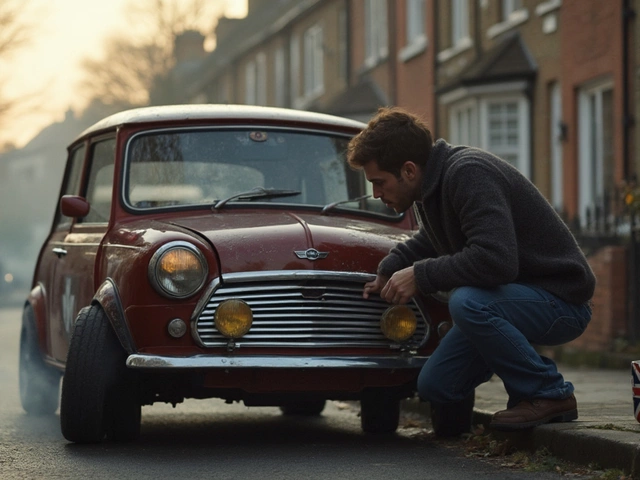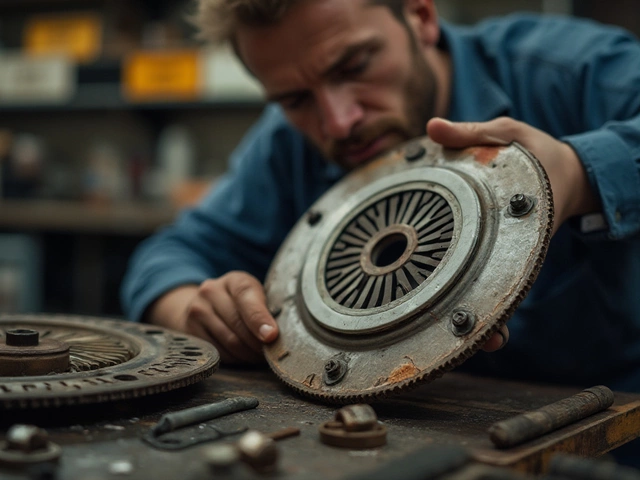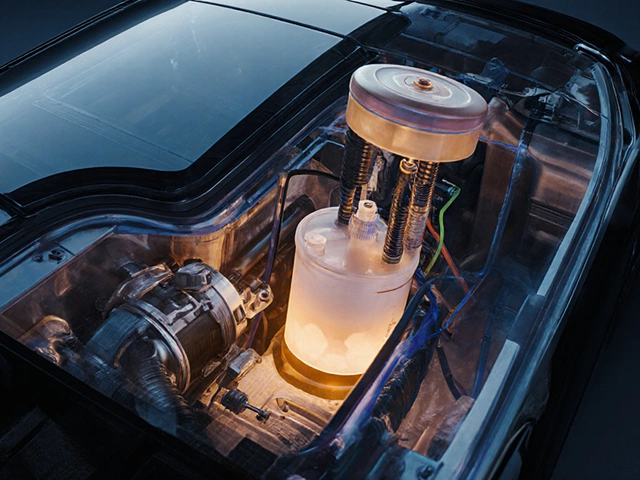Your car's suspension doesn't just keep the ride smooth—it keeps you safe and in control. Ever wondered why your steering feels sloppy or your tires wear out faster than usual? Most of the time, it's a suspension issue hiding in plain sight.
Here's the thing: most drivers don't notice a problem until the car starts making weird noises or driving feels bouncy. By the time you hear that clunk or notice the car pulling to one side, the repair bill usually climbs. That's why it pays to know the most common repairs and what causes them.
I can tell you from experience, ignoring minor issues leads to bigger (and pricier) headaches later. A worn shock absorber won't just make the drive rough—it can mess with your stopping distance. Bad ball joints? Suddenly, turning becomes unpredictable and, honestly, a little scary. I'll walk you through which parts usually give out first, what symptoms you’ll notice, and which fixes are worth tackling yourself.
If you've got a bumpy ride or weird sounds coming from underneath, this guide will help you get to the root of it. With a little know-how, you can spot trouble early on and keep your car handling like new.
- How Your Suspension Actually Works
- Common Symptoms Something’s Off
- Shocks and Struts: Always the First to Go
- Ball Joints and Bushings: The Hidden Troublemakers
- Tie Rods and Control Arms: Keeping Everything Connected
- DIY or Mechanic? Tips for Saving on Repairs
How Your Suspension Actually Works
Your suspension system is like the middleman between your car and the road. It keeps things steady when you hit bumps, potholes, or big dips. Without it, every drive would feel like a rollercoaster ride gone wrong.
The main job of the suspension is to keep your tires on the ground for the best grip and control. It soaks up shock so your steering stays sharp, and your brakes work the way they're supposed to. Miss this, and you risk your car bouncing all over the place or even losing control during a hard turn or stop.
Here’s what actually goes into a typical suspension system:
- Shocks and struts: These absorb the worst of the road impacts, keeping things smooth.
- Springs: They support the weight of your car and help handle bumps.
- Control arms: These connect your wheels to the car’s frame and let them move up and down.
- Ball joints and bushings: They let parts pivot and rotate, making steering possible without horrible noises.
- Tie rods: These connect your steering rack to the wheels, so when you turn the wheel, your car actually turns.
When one of these parts breaks down, the others have to work overtime—and that usually leads to even more problems. For example, a bad strut can mess up tire wear, make steering loose, and even mess with brake performance.
If you like numbers, check this out. According to a 2023 industry survey, suspension parts are among the top five most commonly replaced car components in North America:
| Suspension Part | Average Lifespan (Miles) | Estimated Replacement Rate (%) |
|---|---|---|
| Shocks/Struts | 50,000-100,000 | 45 |
| Ball Joints | 70,000-150,000 | 33 |
| Control Arms | 90,000-120,000 | 28 |
So, when it comes to suspension repairs, it's not just about comfort—it’s about keeping you and your passengers safe every time you hit the road.
Common Symptoms Something’s Off
Most drivers don't realize their suspension parts are wearing out until their car starts acting strange. Here’s what you want to watch for if you think you’re dealing with a suspension problem.
- Bouncy or Rough Ride: If every bump in the road feels like a small earthquake, your shocks or struts might be toast. Good suspension should soak up road imperfections—you shouldn’t feel every crack or pothole.
- Noises When You Hit Bumps: Clicks, clunks, squeaks, or rattles from under your car, especially while turning or driving over speed bumps, are classic warnings. Worn ball joints or bushings love to make themselves heard.
- Pulling to One Side: If you have to tug the steering wheel to drive straight, something’s off. It could be uneven tire wear, bent control arms, or busted tie rods.
- Uneven Tire Wear: Take a look at your tires. If the tread looks mismatched side-to-side, your suspension isn’t holding things steady. You’re basically burning cash with every mile you drive like this.
- Diving, Squatting, or Rolling: Does your car nose-dive when you stop, squat down when you accelerate, or lean hard in turns? These are dead giveaways that your shocks and struts need help.
Here’s a quick breakdown showing how often these symptoms lead to a suspension repairs in real-world garage visits:
| Symptom | Percentage Linked to Suspension Repairs |
|---|---|
| Bouncy Ride | 52% |
| Noises Over Bumps | 43% |
| Car Pulls to One Side | 31% |
| Uneven Tire Wear | 40% |
| Diving/Rolling | 27% |
If you spot more than one of these, get your car checked out sooner rather than later. Problems can go from "annoying" to "dangerous" before you know it.
Shocks and Struts: Always the First to Go
If there’s one suspension repair every driver will eventually face, it’s the replacement of shocks and struts. These two parts handle the grunt work—they soak up bumps, keep your tires in solid contact with the road, and stop your car from bouncing down the street like a trampoline. The catch? They just don’t last forever. Most manufacturers suggest changing them every 50,000 to 100,000 miles, but city driving, potholes, and hauling heavy loads can wear them out faster.
So what’s the difference between them? Shocks (also known as shock absorbers) manage motion and control the bounce after you hit a bump. Struts do the same but add structural support and usually play a part in steering, so if they go bad, you’ll feel it twice as much. Not all cars have both—some have just shocks, some just struts, and some a mix, depending on the suspension design.
| Part | Typical Replacement Interval | Main Symptoms When Worn |
|---|---|---|
| Shocks | 50,000-100,000 miles | Excessive bouncing, poor braking, uneven tire wear |
| Struts | 50,000-100,000 miles | Noisy ride, poor steering control, vehicle "nose dives" when braking |
You’ll usually notice when shocks or struts start going bad. The ride gets rougher, the car doesn’t handle corners like it used to, and stopping suddenly feels mushy or unsafe. Sometimes you’ll spot fluid leaks on the actual part or see the tires wearing in a weird pattern. Here’s what to look for that means you should check or replace them ASAP:
- Car keeps bouncing after a bump or speed bump
- Front end dives or "squats" when braking
- Tires show cupping or patchy wear
- Steering feels loose, especially around corners
- Visible leaks or damage on the shock or strut body
Safe to say, once you spot a few of these signs, don’t wait. Replacing these parts not only brings back a smooth ride—it makes the car suspension repairs way less frequent in the long run and keeps you safer on the road. If money’s tight, most people start with the pair (front or rear) that’s the worst, but keep in mind: replacing both sides at the same time keeps things balanced. Your alignment (and your tires) will thank you later.

Ball Joints and Bushings: The Hidden Troublemakers
These two parts—ball joints and bushings—sit under your car, doing some of the dirtiest work in your suspension. Ball joints connect your steering knuckles to the control arms, letting your wheels move up, down, and side-to-side. Bushings, made of rubber or polyurethane, cushion the joints and hold parts in place while absorbing bumps. When they start to fail, you’ll definitely feel it.
Most folks don’t notice a ball joint issue right away since the early signs are subtle—maybe a small clunk or a little looseness in the steering. But if you ignore that, a worn ball joint can eventually snap. On highways, that’s not the kind of excitement you want. Broken bushings make the car feel sloppy, and every pothole will rattle your teeth. The steering might drift, and you’ll start getting uneven tire wear. Here’s what to watch for:
- Clunking or knocking noises over minor bumps
- Steering that feels loose or uneven
- Car pulling to one side
- Vibration through the steering wheel
- Tires wearing unevenly and faster than normal
Both ball joints and bushings wear down over time as the miles stack up and dirt and road salt eat away at them. In areas with lots of potholes or rough winters, replacements come up way sooner—sometimes before 60,000 miles. Here’s a quick look at how often these parts actually fail:
| Part | Average Lifespan (Miles) | Common Replacement Cost (USD) |
|---|---|---|
| Ball Joints | 70,000 – 150,000 | $150 – $400 per joint (parts & labor) |
| Control Arm Bushings | 60,000 – 100,000 | $200 – $600 set (parts & labor) |
Here’s a tip: when one ball joint or bushing goes out, the rest are probably close behind. If the shop suggests doing these in pairs or sets, they’re not just trying to upsell you—that’s how you avoid repeat trips (and more labor charges). If you like doing your own repairs, tackling bushings is a hassle unless you have a press. Ball joints aren’t much easier, but some trucks have bolt-in options, which make the job less brutal.
No joke, I once ignored a loose ball joint in my truck, thinking I’d deal with it later. One pothole later—dang, I was wishing I’d just fixed it earlier. The best money you’ll spend on suspension repairs is preventive: check these parts every 20,000 miles or if you hear something odd. It’s one of those boring chores that’ll save you from a nasty surprise down the road.
Tie Rods and Control Arms: Keeping Everything Connected
Tie rods and control arms are like the unsung heroes of your car's steering and suspension setup. If you ever wondered why your wheels don’t suddenly veer off on their own or how you keep a straight line at highway speeds, thank these parts.
Tie rods connect your steering rack to your wheels. When you turn the steering wheel, the tie rods push or pull the wheels left or right. If a tie rod end wears out or breaks, steering gets loose and you might notice your vehicle “wandering” or not responding as quickly. Worst case, a broken tie rod can cause you to lose steering entirely—definitely not something you want on the road.
Control arms, on the other hand, act as the link between the car’s frame and suspension. They let the wheels move up and down while keeping everything stable and properly aligned. A worn control arm or its bushings can cause a lot of clunking sounds, uneven tire wear, or even messed-up wheel alignment. If you start getting vibrations in the steering wheel, especially when turning or accelerating, that could be a busted control arm or bushing.
Here’s what to watch out for:
- Knocking or clunking noises when going over bumps
- Steering feels loose or has extra play
- Uneven tire wear for no obvious reason
- The car drifts even after getting a fresh alignment
The good news? These parts are usually straightforward for a mechanic to inspect. Many shops will check tie rods and control arms whenever you bring your car in for a basic suspension check. Replacing a tie rod end isn’t expensive if caught early, but don’t put it off—ignoring it could mean even bigger issues, like extra wear on your tires or damaging your steering rack.
Here’s a quick tip: If you’re worried about these parts, jack up one wheel and try to wiggle it side to side. Too much play is usually a sign it’s time to replace a tie rod or control arm. But if you're not sure, let a professional check it out. When it comes to suspension repairs, handling these early keeps everything safer and a lot cheaper in the long run.
DIY or Mechanic? Tips for Saving on Repairs
When it comes to suspension repairs, a lot of folks wonder if it’s smarter to bust out the tools or just let a pro handle it. Honestly, the answer depends on what’s busted and how comfortable you are crawling under your car.
Let’s break it down. Swapping out shocks and struts can be a home garage job if you’ve got a sturdy jack, some basic wrenches, and a bit of patience. The trickiest part is usually dealing with compressed springs—those things can pack a punch if you’re not careful. Ball joints and bushings can also be tackled by a DIYer, but you’ll need a ball joint press and sometimes a tie rod puller. On the other hand, anything welded or requiring alignment (like control arms or major frame work) is usually better left to the pros.
Here’s where people save (or lose) money:
- DIY Parts Cost: You’ll pay less just picking up parts at a store or online. For example, a typical set of shocks runs $50-$120 per pair. Labor is where shops make their margin—usually double or more the cost of the part.
- Mechanic Labor Rate: Most shops in the US charge anywhere from $70-$150 an hour. Replacing front struts, for example, is about 2 hours per side, so costs add up quick.
- Tools: Sometimes your savings get eaten up by buying or renting special tools (spring compressors, torque wrenches, ball joint presses).
If you’re on the fence, here’s a quick cheat sheet for what’s DIY-friendly and what’s not:
| Repair | DIY | Mechanic Recommended |
|---|---|---|
| Shock/Strut Replacement | Yes, with spring caution | If not comfortable with springs |
| Ball Joint/Bushing Swap | Yes, with right tools | If no tools or experience |
| Tie Rod Ends | Yes | Alignment needed after |
| Control Arm Work | Sometimes | Often needs pro help and alignment |
Want to keep costs low? Always get a second opinion on big repairs and ask for an itemized estimate. Buy your own parts if the shop allows it—sometimes you’ll get them cheaper online. And don’t forget to check for any warranties. Those can easily save you a couple hundred bucks if a part fails prematurely.
One last tip: Watch a couple of YouTube tutorials on your vehicle’s specific repair before you touch anything. Some suspension parts can look straightforward, but model-to-model quirks trip people up constantly. Save yourself the headache by doing your homework first.






